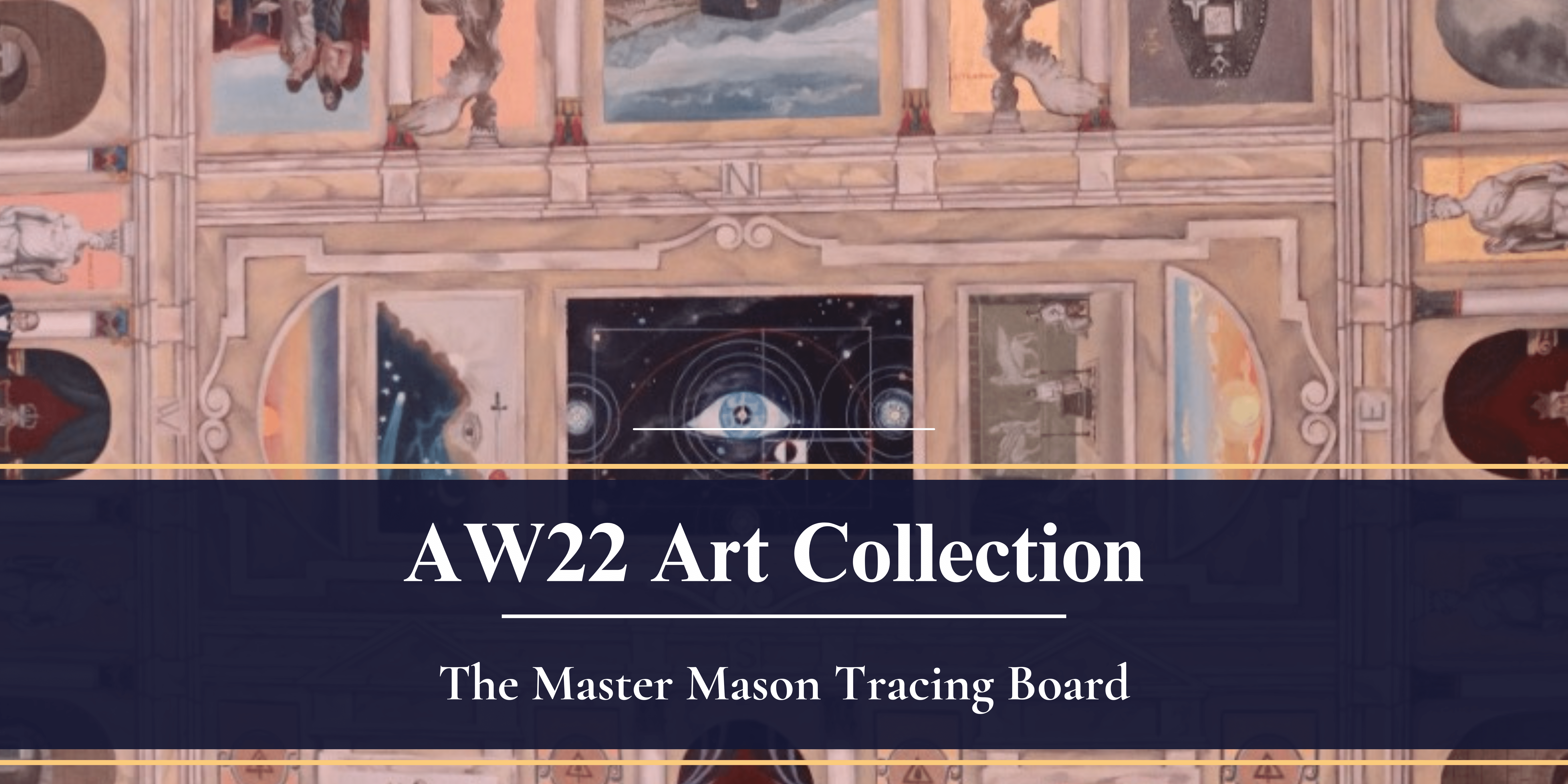The Third Painting by Mavrov is the Master Mason Tracing Board, like the Entered Apprentice and Fellowcraft it has a Plethora of Symbolic meaning which we shall now investigate.
The Trowel


Seen in the middle left of Mavro’s work depicted below. No discourse on the Trowel can be had without first noting the iconic George Washington Trowel kept in the archives of Alexandria-Washington 22 Lodge. This Trowel was used by Brother George in the laying of the corner stone of the Capitol Building and many other iconic and significant American buildings.
The Working Tools “Of a Master Mason are all the implements of Masonry indiscriminately, more especially the Trowel. The Trowel is an instrument used by operative Masons to spread the cement which unites a building into one common mass or whole; but it is used symbolically for the far more noble and glorious purpose of spreading the cement of brotherly Love and Affection, which unities us into one sacred band or society of friends and Brothers – a Temple of living stones, among whom no contention should ever exist, save that noble contention, or rather emulation, of who can best work and best agree.”
“The Trowel does become the chief Working Tool of the Master Mason. He is taught to use it differently than his operative brethren. Instead of spreading cement, the Master Mason uses it symbolically to spread Brotherly Love and Affection. By doing this the Mystic Tie of Freemasonry becomes more binding. Its members are truly united into a Temple of Living Stones.”
Put simply, we as Masons should be examples among our neighbors, friends and loved ones on how to unite everyone by what we have in common, not what separates us. As such we should hold ourselves and each other to a higher standard, so we can strive to achieve that noble goal.

The story about the beautiful Virgin, weeping over a Broken column, and Time
Seen in the top right side of Mavrov’s painting.
“Time, Patience, and Perseverance will accomplish all things, you are told. These are three of the virtues stressed in all training courses for leadership today…These virtues are emblematically represented by a monument of a beautiful Virgin, weeping over a broken column. She holds a sprig of acacia in her right hand, an urn in her left. A book rests upon a broken column. A winged man, representing time, holds the virgin’s hair.
“It is impossible to say exactly at what period the idea of the Monument in the Third Degree was first introduced into the Symbolism of Freemasonry…The Monument adopted in the American System, consists of a weeping virgin, holding in one hand a sprig of Acacia and in the other an urn; before her is a broken column, on which rests a copy of Book of the Constitutions, while Time behind her is attempting to disentangle the ringlets of her hair. The explanation of these symbols will be found in their proper places in this work”
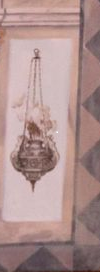
The Pot of Incense
Located on the top left Corner of the MM Tracing Board
“Is an emblem of a Pure Heart, which is always an acceptable sacrifice to Deity; and as it glows with fervent heat, so should our hearts continually glow with gratitude to the great and beneficent Author of our existence, for the manifold blessings And comforts we enjoy”
“The use of incense as a part of the Divine worship was common to all the nations of antiquity. Among the Hebrews, the Egyptians, and the Hindus it seems to have been used for no other purposes; but the Persians burnt it also before the King…It has in Freemasonry a similar signification; and hence the Pot of Incense has been adopted as a symbol of the Third Degree, typifying the pure heart from which prayers and aspirations arise, as incense does from the pot or incensorium.”

The Beehive
Located on the bottom left of the painting.
“Is an emblem of Industry, and recommends the practice of that virtue to all created beings, from the highest Seraph in heaven to the lowest reptile of the dust. It teaches us that as we came into the world rational and intelligent beings, so we should ever be industrious ones, never sitting down contented while our fellow creatures around us are in want, when it is in our power to relieve them without inconvenience to ourselves.”
“Because the Bee is such an energetic insect, never appearing to rest from sunup to sundown, the bee and, hence, the beehive have long been symbols of industry or work. In former times, when more work had to be done by hand and every large piece of construction had to be carried on by great numbers of men, they seemed at a distance to be going and coming as bees”
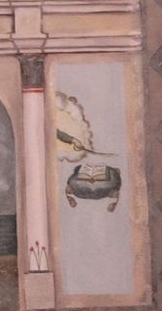
The Book of Constitutions, guarded by the Tiler’s Sword
Found in the bottom right of the painting.
“Reminds us that we should ever be watchful and guarded in our words and actions, particularly when before the enemies of Masonry; ever bearing in remembrance those truly Masonic virtues, silence and circumspection.”
I understand this not just to mean that we should be guarded in giving up the secrets of Freemasonry, but also being circumspect in our own behaviors and speech when in front of Brothers and those who are not Masons. After all, we are representatives of Freemasonry, and represent our Craft, our Lodge and our Grand Lodge when we interact with others.
“The Tiler’s Sword is symbolic of a need in the days when this instrument was the principle means of offense or defense. It may have been used during the days of the operative masons to protect the secrets of the master builder…To Speculative Masons, the Tiler’s Sword should act as a reminder of moral lessons/ It should admonish all of us to “set a guard at the entrance of our thoughts, to place a watch on the door of our lips and to post a sentinel at the avenue of our actions, thereby excluding every unqualified and unworthy thought, word, and deed, and preserving the consciences void of offense toward god and towards man.
“The book of Constitutions, mentioned earlier, is not a symbol of secrecy. It contains the laws of Masonry. It is published for all to read.”

The Sword, pointing to a naked heart
Located just above the central frame of the All-seeing Eye.
“When a Sword Pointing to a Naked Heart was added to the ritual is uncertain. It is referred to as a symbol of Justice. It pointedly reminds us that God will reward us according to what we do in this life. But we know the rewards – the justice – will be tempered with mercy and understanding.”
“Thomas Smith Webb says that “the sword pointing to the naked heart demonstrates that justice will, sooner or later, overtake us”
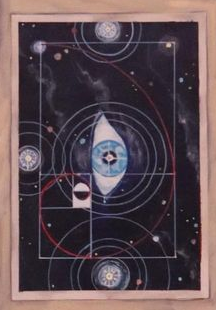
The All-seeing Eye
Located in the center of the tracing board, this symbol above all others (minus likely the Square and Compasses) is one of the most recognizable Masonic Symbol. I do like the added touch that it is ensconced within the celestial bodies above.
“This is naturally a symbol of watchfulness, having the connotation both of solicitude and detection. Thus, it has been the idea of assurance to the good and true, but vengeance to the evil. Hence it is a symbol of omnipresence and watchfulness of the Supreme Being…It is a very old symbol and was used by the Egyptians to represent Osiris. In Preston’s Lecture of the Master Mason degree, the following appears: “The Sword, pointing to a Naked Heart, demonstrates that justice will sooner or later overtake us; and, although our thoughts, words, and actions may be hidden from the eyes of man, yet that All-Seeing Eye, whom the Sun, Moon, and Stars obey, and under whose watchful care, even the Comets perform their stupendous revolutions, pervades the inmost recesses of the human Heart, and will reward us according to our merits.” Preston’s lecture is the oldest Masonic doctrine Freemasons have regarding the All-Seeing Eye, though we do have other sentiments expressed by others in the Craft.
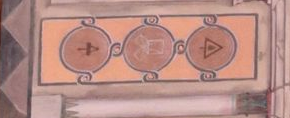
The Forty-Seventh problem of Euclid
Located on center left of the painting.
“Was an invention of our ancient friend and Brother, Pythagoras, who, in his travels through Asia, Africa, and Europe, was initiated into several orders of Priesthood, and raised to the sublime degree of Master Mason. This wise Philosopher enriched his mind abundantly in a general knowledge of things, more especially in Geometry or Masonry. On this subject he drew out many problems and theorems; and among the most distinguished he originated this, when, in the joy of his heart, he exclaimed, – Eureka, – meaning – I have found it-; and upon the discovery, is said to have sacrificed a hecatomb.”
“It is said that when Pythagoras discovered this problem, he sacrificed a hundred oxen, Why? As a mathematical theorem it is of no more importance or interest than fifty or seventy-five others in Euclid; and of much less than most of them. The explanation is a simple one. He styled it “a great symbol.” Mathematical theorems are not ordinarily symbols. He never styled any other theorem a symbol, great or small. A circle, a triangle, a square, a cube are symbols, but I do not know that any other problem has ever been so styled…Only one which represented the numbers 3, 4, 5 was a symbol for him. Its symbolism consisted in its representation of these Numbers, and he called it a symbol, and used it as such, because he could, by means of it, express to adepts, and entrust to his pupils some great philosophical or religious truth or creed, by the use of the measures 3 and 4, and the sum of which is the always sacred number 7.”
The Meaning of the Esoteric Death
Can be seen in several different sections of the painting, and so we can break them up as such.

Setting Maul, Spade and the Coffin;
Found on the right-hand side just above the Sword and Constitutions image.
“These emblems force upon us the solemn thought of Death, which without revelation is dark and gloomy; but the Master Mason is suddenly revived by the ever green and ever living Sprig of Faith in the merits of the Lion of the Tribe of Judah, which strengthens him with confidence and composure to look forward to a glorious immortality beyond the grave.”

The symbols of the Hourglass
Located at the top right corner of the painting.
“An emblem of the passage of time or the brevity of life, and for the purpose, better than a clock, for one can see the sand slowly but steadily wasting away. It is one of the 8 hieroglyphical emblems which came into lectures late in the 18th century. Being coupled with the Scythe, it makes a most impressive symbol, the certainty of death.”
“As a Masonic Symbol it is of comparatively modern date, but the use of the hour-glass as an emblem of the passage of time is older than our oldest known rituals.”

Scythe
While this same image shows time and the weeping virgin, if you look closely enough time is holding the Scythe.
“The Scythe, too, is ritualistically a gloomy instrument, and you were told it is an emblem of time. It is interesting to note that the Hour Glass and Scythe were not symbols employed by Operative Masons. They are, in fact, of comparatively recent origins… The Scythe too is a symbol of Time. It is also a symbol of Learning, and of Immortality.”

The Sprig of Acacia
“The Sprig of Acacia symbolizes Faith- faith in the immortality of man, faith in the promises made by God in His Volume of the Sacred Law.”
“There is some difficulty in retracing the symbolic use of Acacia, though certain it is that some evergreen has been used for many years, possibly centuries, as a symbol of immortality or of a resurrection.”

Anchor and Ark
Are emblems of a well-grounded hope and well-spent life. They are emblematic of that Divine Ark which safely wafts us over this tempestuous sea of troubles, and that Anchor which shall safely moor us in a peaceful harbor, where the wicked cease from troubling and where the weary shall find rest.”
“The Ark pictured in the ritual of Freemasonry is a representation of Noah. Masonically, it symbolizes the passing of the spirit of man from this life to one that is better and everlasting… Those who spent their lives in the service of their God, their country, and their fellow man could hope, and expect, to be safely wafted “Over this tempestuous sea of troubles.”
Brothers, I certainly feel this Symbol is one we should take to heart, ever being servants of our community and country and to the Supreme Architect. Temporal awards may or may not abound, but the rewards to be found in that Temple, not made with hands, eternal in the heavens surely will be worth our labors in the quarries of this life.
- AW22 Website “History of the Silver Trowel”
- Grand Lodge of Virginia Ancient, Free & Accepted Masons Presentation Volume Page 88
- The Craft and its Symbols by Allen E. Roberts Page 65
- IBID page 67
- Mackey’s Encyclopedia Volume II page 677
- Grand Lodge of Virginia Ancient, Free & Accepted Masons Presentation Volume Page 92
- Mackey’s Encyclopedia Volume I page 477
- Grand Lodge of Virginia Ancient, Free & Accepted Masons Presentation Volume Page 93
- Coil’s Encyclopedia page 90
- Grand Lodge of Virginia Ancient, Free & Accepted Masons Presentation Volume Page 94
- The Craft and its Symbols by Allen E. Roberts Page 73
- IBID page 74
- IBID page 76
- Mackey’s Encyclopedia Volume II page 1001
- Coil’s Encyclopedia page 27
- Grand Lodge of Virginia Ancient, Free & Accepted Masons Presentation Volume Page 95 and 96
- Albert Pike’s Esoterika page 192
- Grand Lodge of Virginia Ancient, Free & Accepted Masons Presentation Volume Page 97
- Coil’s Encyclopedia page 314
- Mackey’s Encyclopedia Volume I page 466
- The Craft and its Symbols by Allen E. Roberts Page 79
- The Craft and its Symbols by Allen E. Roberts Page 80
- Coil’s Encyclopedia page 2
- Grand Lodge of Virginia Ancient, Free & Accepted Masons Presentation Volume Page 95
- The Craft and its Symbols by Allen E. Roberts Page 76



